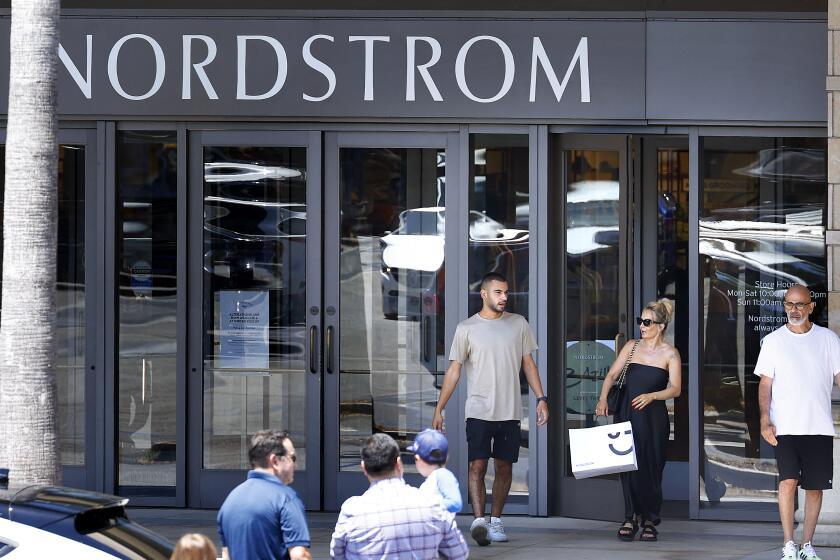Secondhand Sales Let You Clean Up in 2 Capacities
- Share via
When Kathy Danenberg decides to clean out her garage, she takes her cue from department store clearance sales.
She places ads for her garage sale in the newspaper, posts signs all over her Simi Valley neighborhood and even uses marketing ploys to increase business. She has earned as much as $1,600 for a weekend’s work.
“It’s fun, it’s a great way to clear out the house of unwanted things, and the extra money is always nice,” she said.
Danenberg is one of many people who have turned unwanted items into cash through garage sales, swap meets, antique stores or classifieds ads.
In 1973, the Saugus Swap Meet attracted 15,000 potential buyers and 400 vendors on a typical Sunday. Now, 15 years later, more than 20,000 people and 800 vendors show up, with about 200 of the merchants selling secondhand items, said Ray Wilkings, general manager of the Saugus Swap Meet.
“Many of these people are clearing out their garages. They bring antiques, clothing, furniture, just about anything imaginable. Some of them haul it in by the truckload and sell everything for 25 cents,” Wilkings said. Most of the items for sale fall into the knickknack, clothing or secondhand electronics categories.
Vendors at the Saugus Swap Meet, held at the Saugus Speedway on Soledad Canyon Road, pay between $20 and $40 each Sunday to rent a space, and many of them keep coming back. “The reason it is so popular is that you can’t get so much exposure at a garage sale or anywhere else,” Wilkings said. “Besides, it’s an outing. It’s not a mall, it’s out in an open area that has an atmosphere all its own.”
More than 600 vendors show up for the Van Nuys Indoor Swap Meet and the Valley Indoor Swap Meet in Sepulveda each weekend.
Although a swap meet pulls in hundreds of potential buyers, many sellers balk at the idea of paying for a selling spot. Some, like Danenberg, prefer the low cost and homeyness of a garage sale.
“The problem with a swap meet is that you have to haul everything there. And then you don’t have all the comforts of home,” Danenberg said. “The advantage of a garage sale is you can take turns. You can also meet interesting people, including your neighbors.”
Danenberg has transformed a simple idea into a sophisticated operation. She creates super sales with several neighbors. Then she drives by the house after everything is set up to make sure the displays are neat and that attractive merchandise is visible from the street. She also offers a “kid box” with free items, gives away plants with a minimum purchase and puts up signs that encourage haggling. She arranges for local charities to come and pick up whatever is left over on Monday.
Danenberg’s $1,600 weekends are not typical; most people who run their own garage sale make $50 to $100 a day. In the city of Los Angeles residents are allowed up to three sales a year without a permit. In Burbank, home owners can have one sale a year, but must obtain a free permit.
Some Pick Classified Ads
People with fewer things to sell or with more expensive items such as furniture, cars and major appliances frequently opt for the classified ads. “It’s simple, it’s easy, and it usually is effective,” said Rob Carmen of San Fernando, who has used the ads to sell merchandise.
In the San Fernando Valley, dozens of publications print tens of thousands of ads each week. One of the popular sources of leads is the Recycler, billed as the world’s largest “free ad” newspaper. It prints 22,000 ads in the San Fernando Valley edition--one of seven editions that altogether carry 100,000 ads a week. (The first edition of the Recycler, in 1973, carried 1,821 ads.)
About 90% are placed by people with something to sell, said spokeswoman Barbara Ackerman; the other 10% are placed by people who offer or are looking for various services, have something to rent or having something to give away, such as pets. The March 10 editions had more than $176 million worth of items for sale.
The Recycler’s ads cover more than 400 categories ranging from nursery furniture and aquariums to musical instruments and comic books. One recent edition even carried advertisements for such items as an authentic Amish dry sink for $1,200, a collection of 1,000 beer bottle labels for $20, and a helium neon laser for $125.
Local secondhand stores and antique shops also have their share of unusual items.
At The It Shop in Burbank, owner James McCallister stocks thousands of items ranging from semi-valuable art pieces to inexpensive trinkets. “I try to keep a wide variety of things in the store,” he said. “That way my chances of selling things increases greatly.” On one wall are a couple of mounted deer heads; below them are a few old phonograph records from the 1940s.
McCallister’s merchandise comes from people who want to get rid of old items, estates, swap meets, and “pickers” who find items at garage sales.
“It’s a full-time job looking for things,” he said. “You don’t just work 9 to 5 and then go home. People are constantly calling you to come over and look at something. And even if you force yourself to take a day off, you always have your eyes open for someone who has something to sell. It’s kind of like prospecting. There’s always the lure of finding the big bounty for a small amount of money.”
McCallister recalls the time he bought an oil painting at a swap meet for $7, then turned around and sold it for $350 to a customer. But that was unusual. “It’s buying and selling all the smaller items, playing the percentages, that keeps you in business,” he said. Prices in the store range from $1 to $3,000, with most items going for between $5 and $50.
“There is a tremendous demand for used merchandise,” said Carl Crabb, who runs the Victorian Rose antique shop, across the street from The It Shop in a stretch of Burbank known as Antique Row. “And, obviously, there are lots of people interested in selling things. We get three or four people a day coming in to sell.”
Some want to cash in costume jewelry, others to sell antique furniture, books and china. Many, Crabb said, are older people who need money or have run out of room.
Of course, for those who make money selling off their old things, the profits usually don’t last too long. “I usually wind up channeling the money back into other household items,” Danenberg said. “And some of those things wind up in later sales.”
More to Read
Inside the business of entertainment
The Wide Shot brings you news, analysis and insights on everything from streaming wars to production — and what it all means for the future.
You may occasionally receive promotional content from the Los Angeles Times.










